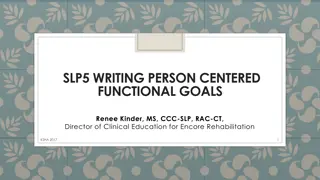Mastering Effective Online Speech Delivery
Dive into strategies and challenges for successful online speaking, including adapting your speech, engaging virtual audiences, and adjusting communication styles for online platforms. Explore synchronous vs. asynchronous scenarios, face-to-face vs. online speaking differences, and tips for enhancing verbal communication online.
Download Presentation

Please find below an Image/Link to download the presentation.
The content on the website is provided AS IS for your information and personal use only. It may not be sold, licensed, or shared on other websites without obtaining consent from the author.If you encounter any issues during the download, it is possible that the publisher has removed the file from their server.
You are allowed to download the files provided on this website for personal or commercial use, subject to the condition that they are used lawfully. All files are the property of their respective owners.
The content on the website is provided AS IS for your information and personal use only. It may not be sold, licensed, or shared on other websites without obtaining consent from the author.
E N D
Presentation Transcript
Public Speaking Module 12: Public Speaking Online
Module Learning Outcomes Explain some of the strategies and challenges for effective online speaking 12.1: Identify ways to adapt your speech to online delivery 12.2: Identify the particular challenges of engaging an audience online 12.3: Identify various scenarios of online speech
Learning Outcomes: Adapting to Speaking Online 12.1: Identify ways to adapt your speech to online delivery 12.1.1: Explain the similarities and differences in speaking to face-to-face and online audiences 12.1.2: Compare synchronous and asynchronous scenarios in online speaking 12.1.3: Describe the adjustments you need to make to your verbal communication when speaking online 12.1.4: Describe the adjustments you need to make to your nonverbal communication when speaking online 12.1.5: Summarize the lighting, camera, and sound needs for online speaking environments
Face-to-Face vs Online Speaking DIFFERENCES SIMILARITIES Clear purpose Focused thesis Developed main points with evidential support Audience analysis Physical proximity May not see the audience Miss nonverbal cues and feedback
Synchronous vs Asynchronous Synchronous Asynchronous Real time with a live online audience Uses Web conferencing /virtual communication software Audience may be together or watching from individual devices A speaker may be able to get real-time feedback and adapt accordingly Pre-recorded for audience to view later Delivered straight to a camera with no audience No feedback from audience Combined Delivered in front of a live audience and recorded for later use Examples: TedTalks, online meetings or townhalls, etc.
Class Discussion: Synchronous or Asynchronous? What are the advantages and disadvantages of each delivery type? To the speaker? To the audience?
Verbal Communication Online Vary speaking pace Speak slower than usual Pause occasionally Short, half-second stops between phrases Vary tone Vary more than in normal conversation Stress key words for emphases Record and listen to yourself
Nonverbal Communication Online Awareness of the environment Background of the room Objects that appear in the frame Clear clutter or mess Consider using a backdrop Choose a quiet room free of interruptions Speak while seated Posture Work harder to convey enthusiasm and energy Eye contact Look at the webcam, not the screen Keep the camera at eye level Use deliberate hand gestures Avoid using too much movement Keep them natural Keep them in frame Clothing Avoid clothes with stripes, busy prints, or white Solid colors are best
Technical Considerations Lighting Avoid backlighting Speak facing a window or other light source Camera Align your face to the middle of the frame Use a solid, steady surface for tripod and camera Do not record in horizontal or landscape mode Sound Use a headset or earbuds with a microphone (or) Use a wired or wireless microphone Double check input volume settings to ensure you are loud enough Test the system by recording a couple of practice speeches Volume, eye contact, lighting
Practice Question 1 When preparing for an online speech, what technical consideration will ensure that your audience is not distracted by background noise? A. Use either a separate microphone or a microphone attached to a headset B. Turn down the volume on your computer s volume input C. Speak loudly and close to the microphone D. Turn up the volume on your computer s volume input
Practice Question 2 Asynchronous online speeches are different from synchronous online speeches in what way? A. The audience is not in the same room B. The speaker must maintain eye contact with the camera for an asynchronous speech C. The speaker cannot adapt to real-time feedback during an asynchronous speech D. The speaker cannot adapt to real-time feedback during a synchronous speech
Practice Question 3 When preparing to deliver a speech online, how should you orient yourself and the camera to a light source ? A. An overhead light should be directly above you and the camera B. Soft lamps should be behind you, facing the camera C. A window or natural looking light should be in front of you, behind the camera D. A window or natural light should be behind you and facing the camera
Learning Outcomes: Challenges with an Online Audience 12.2: Identify the particular challenges of engaging an audience online 12.2.1: Summarize ways to engage audiences in online settings 12.2.2: Discuss the ways to eliminate distractions for online audiences 12.2.3: Presentation aids in an online setting
Engaging the Online Audience Use of Presentation Aids Do not replace your presence with a narrated slideshow Use slides selectively only to: Emphasize key points Explain important concepts Interaction Tools Polls Virtual raised hands Chat features Word Clouds
Eliminating Distractions Video Distractions Consider turning video off for larger webinars or meetings until Q&A Audio Distractions Mute your audience s audio until Q&A Chat Provide instructions for how you will use the chat feature Avoid monitoring the chat while you present Use chat feature at dedicated times Ask a co-presenter to monitor chat Hide Self-View Avoid looking at your own picture
Presentation Aids Online Use sparingly in Presentations They can take over the entire screen, and the audience will not see you Practice transitioning between the slide and the camera Show your face alongside slides when using them Try to use split screen Avoid using full screen for the slide
Practice Question 4 Which answer below is a good strategy to encourage engagement with an online audience? A. Increase the number of slides so the screen changes more frequently B. Leave the chat feature on for the entire presentation C. Use online interaction tools like a poll or chat D. Do not use any presentation aids
Class Activity: Create engagement prompts Break into groups of 4 Imagine that your group will be delivering a speech about adopting a pet Together, brainstorm 1) A poll question with options 2) A reason to ask them to raise their hand if 3) A word cloud prompt (think of a word that you associate with ) 4) A question for your audience to answer in the chat Once you have all three engagement prompts, determine when you will use them in your presentation (This may require you to brainstorm main points)
Learning Outcomes: Online Speaking Scenarios 12.3: Identify various scenarios of online speech 12.3.1: Identify strategies for running a webinar 12.3.2: Demonstrate strategies for managing Q&A online 12.3.3: Identify strategies for participating effectively in an online meeting 12.3.4: Identify strategies for online interviews
Types of Webinars Webinars : a presenter shares information through a video conferencing tool Presentation slides are often used Audience interaction is common General Information Sales Demo Training Team Meetings Features and benefits of a product are described to an audience of potential customers Explanation of how to successfully complete a process, task, or use a product Facilitating a meeting among colleagues working together or a shared task Information about a subject, service, or product Like an informative speech May use persuasive structure or strategies
Running a Webinar 1. Identify your objectives 2. Learn the software platform 3. Create a project plan Identify assignments and deadlines 4. Create an agenda and content outline Include places for your Q&A 5. Create visuals 6. Rehearse the presentation 7. Present the webinar
Successful Questions and Answers Option 1: Create several short breaks throughout for questions and answers Option 2: Wait until all information has been presented to answer questions Best practices: Use chat feature instead of audio Repeat the question before answering so everyone can hear it Don t rush your answer Tie the answer back to the webinar objective(s) Ask the questioner if your answer addressed what they wanted to learn
Class Discussion : Q&A options What are the benefits and drawbacks of each Q&A option: short breaks throughout or waiting until the end? To the speaker? To the audience?
Online Meetings The 60-Second rule Help a group solve a problem by doing something in the first 60 seconds to help them understand it. Example: provide an anecdote The Responsibility Rule Create an expectation of shared responsibility early in the meeting The Nowhere-To-Hide Rule Give people tasks that they must actively engage in The MVP Rule Minimum Viable PowerPoint slide The Five-Minute Rule Don t go longer than five minutes without giving your audience an opportunity to interact
Online Interview Best Practices Test your video and audio Turn off distractions Make sure your laptop or tablet is fully charged Dress professionally head to toe Keep your background professional and free of distractions Organize materials around your screen Maintain eye contact (with the camera) Practice Record yourself practicing
Practice Question 5 In what way would engagement opportunities differ in a team meeting than in a webinar? A. The engagement opportunities between a team meeting and a webinar are the same B. A team meeting should have an engagement opportunity at least every 5 minutes C. A webinar should chat available at all times D. Webinar participants should be given tasks in which they must actively engage
Practice Question 6 Alex wants to use the chat feature for questions and answers during his webinar. What is the best way for Alex to run his Q&A? A. Unmute all microphones during Q&A only B. Direct all chats to public so that the audience can answer each other s questions C. Quickly answer as many questions as he can to ensure as many people as possible are heard D. Repeat the question before answering and ask the questioner after answering whether he address what they wanted to learn
Quick Review Online speaking environments must take lighting, camera position, microphone, and visible background into consideration An online speech can be synchronous, asynchronous, or combined Asynchronous speeches are pre-recorded with no opportunity to adapt to live feedback Delivery techniques must be adapted to an online audience: Increased vocal variety, pauses, and speaking slower are important vocal adaptations to speaking online When speaking online, always look at the camera, not the screen To engage an online audience, use chat features and minimal PowerPoint slides Minimize distractions of an online audience by muting microphones and audio Online Speech scenarios include webinars, meetings, and interviews Preparation, recorded rehearsals, and familiarity with software is the key to success Increase participant visibility, responsibility, and engagement opportunities in online meetings


![Prevention and Combating of Hate Crimes and Hate Speech Bill [B.9B.2018]](/thumb/60513/prevention-and-combating-of-hate-crimes-and-hate-speech-bill-b-9b-2018.jpg)




















